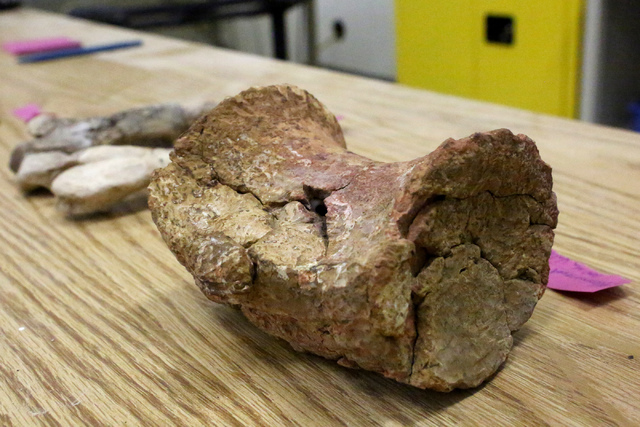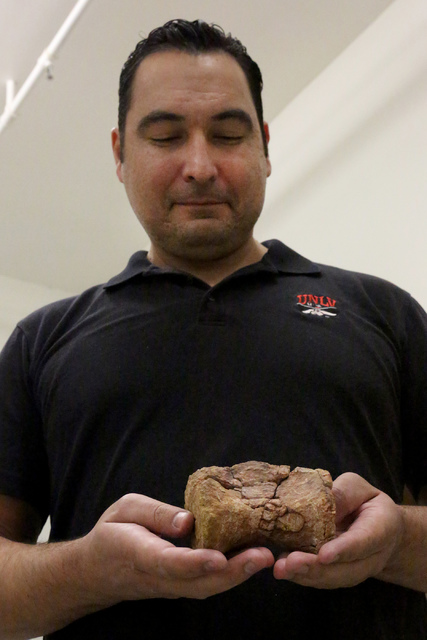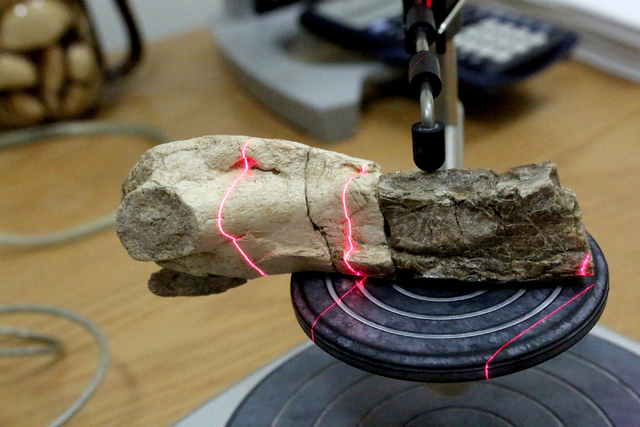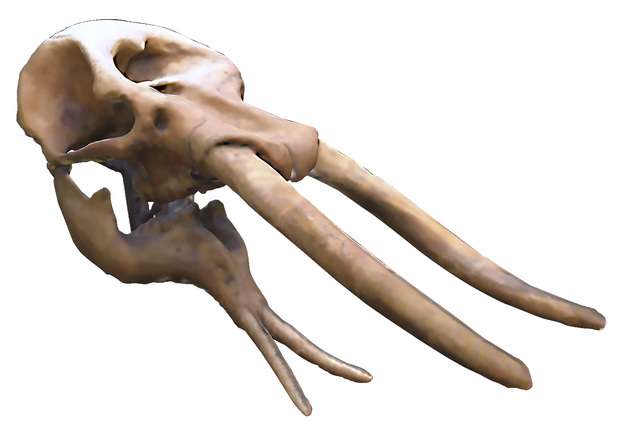Scientist makes 3-D images of artifacts from Las Vegas museum to share online
Bernard Means is, technically speaking, a scientist. But he’s also an artist of sorts who works in the media of digital imagery and, sometimes, bones.
Lots and lots of bones, fossilized now, but which once allowed giant creatures to amble, walk, crawl or thunder across such locales as Southern Nevada.
Means, an anthropology instructor at Virginia Commonwealth University and director of the school’s virtual curation laboratory, last week brought his scientific and artistic skills to Las Vegas, where he spent four days capturing 3-D digital images of artifacts housed at the Las Vegas Natural History Museum.
The 3-D digital representations of the objects (https://sketchfab.com/virtualcurationlab/collections/las-vegas-natural-history-museum) will be available to researchers around the world as well as teachers, students and anybody else seeking to explore Nevada’s past or artifacts from elsewhere that are housed here now. More than 40 skulls, thigh bones, limbs and other fossilized parts of dinosaurs, as well as cultural artifacts also housed by the museum, were scanned.
Means came to Las Vegas under the auspices of the Smithsonian Institution’s Smithsonian Affiliations program, says Marilyn Gillespie, executive director of the museum.
There are more than 200 affiliates in the United States, Puerto Rico and Panama working with the Smithsonian, which is based in Washington, D.C. Through the program local museums and the Smithsonian share exhibits and collections, collaborate on research and work to create educational opportunties for museumgoers. The Las Vegas Natural History Museum and the National Atomic Testing Museum, also in Las Vegas, are Nevada’s only two Smithsonian affiliates.
Laura Hansen, national outreach manager for Smithsonian Affiliations, says the goal of last week’s 3-D scanning project is to make at least part of the Las Vegas museum’s collection more accessible to paleontologists and other researchers.
“You could be in Iceland and you could search the Las Vegas Natural History Museum,” she says.
The images also might serve as an incentive in persuading online browsers to visit the museum in person.
“We think that if we put things online, people won’t want to come to the museum, and what museum professionals find is exactly the opposite,” Hansen says. Seeing items online actually spurs their interest in visiting the museum, where they view the other collections as well.
Joshua Bonde, assistant professor in residence for paleontology at UNLV, compiled the list of candidates for scanning. Gillespie says the wish list included objects of both paleontological and archaeological interest, from fossils to items from the museum’s “Treasures of Egypt” exhibit.
Bonde — who also serves as the museum’s director of conservation and research — says the items included the skull of an elephant-like Gomphothere and the backbone of an allosaur-like dinosaur, as well as the skull of an elephant-like Rhynchotherium that’s 4 million to 5 million years old.
While that last fossil actually comes from Arizona and is part of the museum’s permanent collection — it is, Bonde notes, “the best example of its kind in the world” — the fossils that were scanned came almost entirely from Nevada and such locales as Valley of Fire State Park, Spring Mountain Ranch State Park and Tule Springs Fossil Beds National Monument.
Smaller specimens were positioned on a small stand and scanned in a process that took as long as an hour. Tusks and skulls and larger specimens were scanned using a hand-held scanner. Means says hand scanning larger objects typically takes 5 to 10 minutes, although the resolution of the image isn’t as detailed.
The three-dimensional digital images obtained can be edited by sophisticated software to the point of using a mirroring function to create an opposite bone where none exists, Means says. The images then were uploaded to the website, where researchers can view and manipulate them on a computer screen or even make physical replicas using a 3-D printer.
Means calls the process of digitally scanning museum objects “virtual curation,” which he has defined as creating “intangible digital models from tangible artifacts.” It can, he has written, enhance “the preservation of artifacts while significantly increasing how much and in what ways people can access objects from the past.”
The Las Vegas Natural History Museum project is the second that Means has done under Smithsonian auspices. Means estimates he has scanned museum-worthy objects for about 50 institutions since 2011.
Among the stranger objects he has scanned: a ham cured in 1902 which, he says, the museum that owned it claimed to be “the world’s oldest ham.”
Bonde and Means say the plan was to scan as many objects as time would allow, knowing they would fall far short of accommodating everything the museum holds.
Gillespie notes that the museum during the past year or so has welcomed the return of thousands of items and artifacts from Southern Nevada that were being stored elsewhere.
“Our history was leaving us, and we’re able now to keep it and tell the stories that happened in our past,” she says. “But we are really excited about this program with the Smithsonian affiliates, being able to get so much information out.”
Bonde says the project represents one way to share “Nevada’s heritage around the world.”
And if he could? “I’d scan the entire collection,” Bonde says, laughing.
Read more from John Przybys at reviewjournal.com. Contact him at jprzybys@reviewjournal.com and follow @JJPrzybys on Twitter.






















